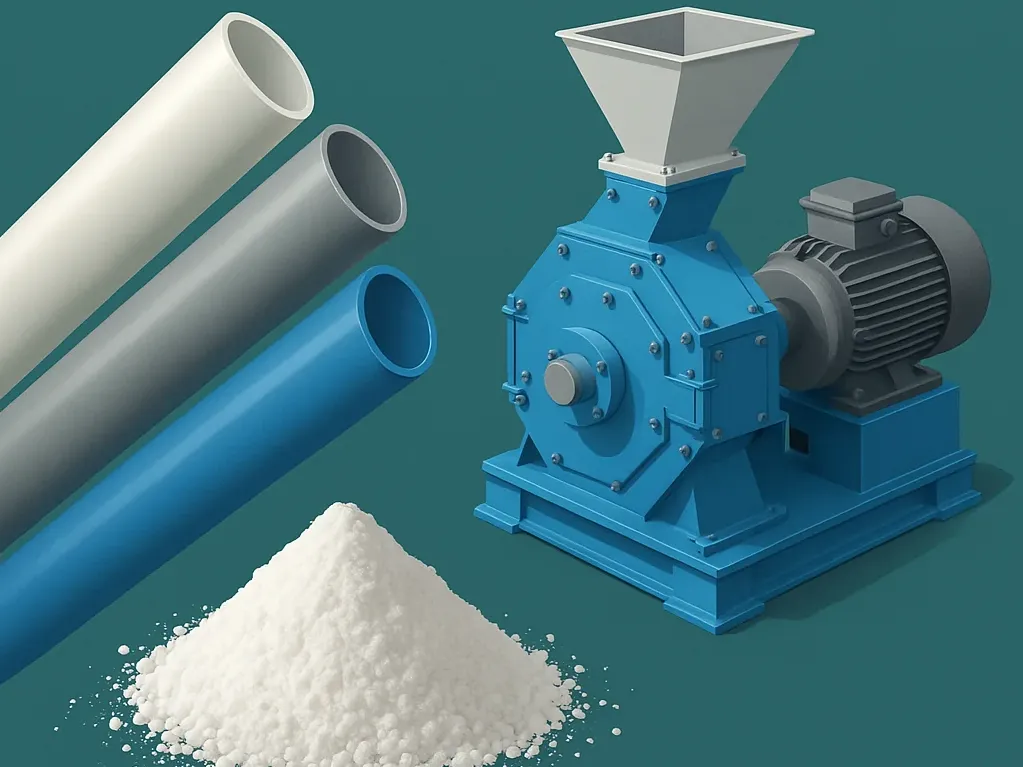Polyvinyl chloride (PVC) is a versatile and widely used polymer in industries ranging from construction to packaging. However, processing PVC into fine powders for applications like coatings, pipes, or fittings requires pulverizers—specialized machines that grind PVC into uniform particles. The efficiency and performance of these pulverizers heavily depend on the PVC formulation being processed. Variations in additives, such as plasticizers, stabilizers, and fillers, can significantly influence pulverizer performance, affecting throughput, energy consumption, and product quality. In this article, we’ll explore how different PVC formulations impact pulverizer performance and provide practical strategies to optimize processing outcomes.
Understanding PVC Formulations and Their Components
PVC formulations are not one-size-fits-all. They are tailored to meet specific application needs by blending raw PVC resin with additives. These additives modify the material’s properties, such as flexibility, durability, and thermal stability, but they also alter how the material behaves during pulverization. Key components include:
- Plasticizers: These soften PVC, making it more flexible (e.g., phthalates like DEHP). Flexible PVC is common in cables and films but can be sticky or prone to agglomeration during grinding.
- Stabilizers: Heat stabilizers (e.g., calcium-zinc or organotin compounds) prevent degradation during processing. They influence the material’s thermal behavior in pulverizers.
- Fillers: Materials like calcium carbonate enhance rigidity and reduce costs but can increase abrasion on pulverizer components.
- Impact Modifiers: Additives like chlorinated polyethylene (CPE) or acrylics improve toughness, potentially affecting particle size distribution.
Each of these components changes the physical and chemical properties of PVC, which in turn impacts pulverizer efficiency. Let’s dive into how these variations play out during processing.
How PVC Formulations Affect Pulverizer Performance
Pulverizers, whether disc mills, hammer mills, or cryogenic systems, rely on consistent material behavior to achieve optimal results. Different PVC formulations introduce challenges that can disrupt this consistency. Here’s how:
1. Hardness and Brittleness
Rigid PVC formulations, often used in pipes and profiles, contain minimal plasticizers and higher filler content. These materials are harder and more brittle, making them easier to fracture into fine particles. However, excessive fillers can wear down pulverizer blades or discs, increasing maintenance costs and downtime. Conversely, plasticized (flexible) PVC is softer and more elastic, resisting fracture and potentially clogging the system due to heat-induced stickiness.
2. Thermal Sensitivity
PVC is thermally sensitive, and stabilizers play a critical role in maintaining stability during pulverization. High-speed pulverizers generate heat through friction, which can degrade poorly stabilized PVC, leading to discoloration or chemical breakdown. Formulations with robust stabilizers can withstand higher processing temperatures, improving throughput, while those with insufficient stabilization may require slower speeds or cooling systems, reducing efficiency.
3. Particle Size Distribution
The goal of pulverization is a uniform particle size, typically in the 100-500 micron range for PVC powders. Additives like impact modifiers or fillers can alter the material’s fracture mechanics. For instance, high filler content may result in finer particles but increase dust, while plasticized PVC might produce irregular, coarser particles due to its elasticity, necessitating adjustments in pulverizer settings.
4. Energy Consumption
Softer, plasticized PVC formulations demand more energy to grind due to their resistance to breaking. Rigid formulations, while easier to pulverize, may contain abrasive fillers that increase wear on equipment, indirectly raising energy costs through frequent repairs. Balancing formulation design with pulverizer performance is key to minimizing energy use.
5. Equipment Wear and Tear
Fillers like calcium carbonate or titanium dioxide are abrasive, accelerating wear on pulverizer components such as blades, screens, and liners. Plasticized PVC, on the other hand, can leave sticky residues, requiring frequent cleaning. These factors directly impact maintenance schedules and operational costs.
Practical Strategies to Optimize Pulverizer Performance
Understanding the interplay between PVC formulations and pulverizer performance opens the door to actionable strategies. Here are proven approaches to enhance efficiency, reduce costs, and maintain product quality:
1. Tailor Pulverizer Settings to the Formulation
Adjusting pulverizer parameters—like disc gap, rotor speed, or feed rate—can compensate for formulation differences. For rigid PVC, increase rotor speed to leverage its brittleness for finer grinding. For plasticized PVC, lower speeds and wider gaps can prevent overheating and sticking, ensuring smoother operation.
2. Incorporate Cooling Systems
Heat is a pulverizer’s enemy when processing PVC. Cryogenic pulverizers, which use liquid nitrogen to cool the material, excel with flexible PVC by making it brittle and easier to grind. For less extreme cases, air-cooling or water-jacketed systems can maintain optimal temperatures, especially for thermally sensitive formulations.
3. Select the Right Pulverizer Type
Not all pulverizers are created equal. Disc mills are ideal for rigid PVC due to their precision and ability to handle brittle materials. Hammer mills suit coarser grinding of mixed formulations, while cryogenic systems shine with sticky, plasticized PVC. Matching the machine to the formulation prevents bottlenecks and improves output.
4. Optimize PVC Formulation Design
Collaboration between formulation chemists and processing engineers can yield big wins. Reducing filler content slightly or switching to less abrasive options (e.g., precipitated calcium carbonate) can lower equipment wear. Enhancing stabilizer levels in heat-sensitive formulations ensures stability during high-speed pulverization, boosting throughput.
5. Regular Maintenance and Blade Upgrades
Abrasion and residue buildup are inevitable, but proactive maintenance mitigates their impact. Schedule regular inspections and replace worn blades with high-durability materials like tungsten carbide for abrasive formulations. For sticky PVC, non-stick coatings on components can reduce cleaning frequency.
6. Monitor Particle Size and Adjust Feed Rates
Inconsistent particle sizes signal a mismatch between formulation and process. Use real-time particle size analyzers to fine-tune feed rates and pulverizer settings. Slowing the feed for plasticized PVC prevents overloading, while increasing it for rigid PVC maximizes throughput without compromising quality.
Case Study Insights: Real-World Applications
Consider a manufacturer producing rigid PVC pipes versus one making flexible PVC cables. The pipe producer uses a formulation with 20% calcium carbonate and minimal plasticizer, achieving high pulverizer throughput with a disc mill at 3000 RPM. However, blade wear increases 15% faster due to abrasion, prompting a switch to carbide-tipped blades, which extends maintenance intervals by 25%.
In contrast, the cable producer’s plasticized PVC (30% DEHP) causes frequent clogs in a standard disc mill. By adopting a cryogenic pulverizer and reducing rotor speed to 2000 RPM, they eliminate sticking, improve particle uniformity by 20%, and cut energy costs by 10% through reduced downtime.
These examples highlight how formulation-specific strategies can transform pulverizer performance, delivering measurable ROI.
Future Trends in PVC Pulverization
As sustainability gains traction, recycled PVC (rPVC) is becoming more common. rPVC often contains mixed additives from its prior life, posing new challenges for pulverizers. Innovations like AI-driven process optimization and advanced cooling technologies are emerging to handle these complexities, ensuring consistent performance across diverse formulations.
Conclusion: Balancing Formulation and Performance
The impact of PVC formulations on pulverizer performance is undeniable—hardness, thermal sensitivity, and additive content shape every aspect of the grinding process. By understanding these dynamics and applying targeted strategies, manufacturers can optimize throughput, reduce costs, and maintain high-quality output. Whether you’re processing rigid PVC for construction or flexible PVC for packaging, aligning your pulverizer setup with your formulation is the key to success. Start by auditing your current process, experimenting with adjustments, and collaborating with formulation experts to unlock peak performance.



